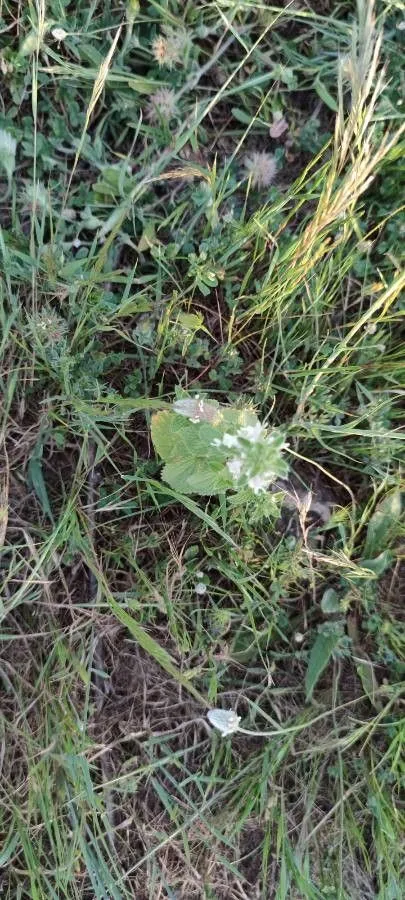
Author: (L.) Briq.
Bibliography: H.G.A.Engler & K.A.E.Prantl, Nat. Pflanzenfam., Nachtr. 1: 291 (1897)
Year: 1897
Status: accepted
Rank: species
Genus: Stachys
Vegetable: False
Observations: Macaronesia, Medit.
The Italian hedgenettle, scientifically known as Stachys ocymastrum, is a distinctive member of the Lamiaceae family. This perennial plant draws interest both for its botanical characteristics and its geographical distribution. Originally described by prominent botanists H.G.A. Engler and K.A.E. Prantl in their work ‘Nat. Pflanzenfam., Nachtr. 1’, published in 1897, this species was later categorized under its current scientific name by (L.) Briq.
Native to the regions of Macaronesia and the Mediterranean, Stachys ocymastrum thrives in these specific climates, adapting well to the local conditions. The plant exhibits typical features of the Lamiaceae family, including square stems and opposite leaves, which are significant traits aiding in its identification.
The foliage of the Italian hedgenettle is aromatic, a characteristic that is common among many members of its family, making it easily noticeable and a favorite amongst botanists and plant enthusiasts. The leaves are usually covered in fine hairs, contributing to their textured appearance.
The flowering aspect of Stachys ocymastrum is equally captivating, with flowers that usually bloom in terminal spikes. These flowers can vary in color, but often exhibit shades that attract a variety of pollinators, thereby playing a significant role in the ecological balance of their native habitats.
Beyond its ecological contributions, the Italian hedgenettle also holds a place in traditional uses, particularly within the Mediterranean region, though these uses are less documented compared to other members of the Stachys genus.
Overall, Stachys ocymastrum serves as a valuable part of its native flora, with its intricate blend of physical beauty and ecological importance. As more studies continue to explore its properties and uses, the appreciation for this elegant plant only grows deeper.
Eng: italian hedgenettle
En: Italian hedgenettle, Hairy Woundwort
Ca: Alfabregueta
Fr: Épiaire hérissée
De: Basilikum-Ziest
Taken May 1, 2022 by ArthemisApollo (cc-by-sa)
Taken May 18, 2021 by Perlas Gore (cc-by-sa)
Taken Apr 21, 2015 by Tela Botanica − Hervé Goëau (cc-by-sa)
Taken Apr 23, 2020 by Bouzid (cc-by-sa)
Taken Jun 7, 2021 by J (cc-by-sa)
Taken Mar 12, 2022 by Alicia Nebot (cc-by-sa)
Taken Apr 21, 2015 by Tela Botanica − Hervé Goëau (cc-by-sa)
Taken Apr 23, 2016 by Tela Botanica − Liliane ROUBAUDI (cc-by-sa)
Taken Apr 21, 2015 by Tela Botanica − Hervé Goëau (cc-by-sa)
Taken Apr 11, 2021 by Herrero Pere (cc-by-sa)
Taken Apr 22, 2021 by Rodríguez Rafael (cc-by-sa)
Taken Mar 12, 2021 by Rui Delgado (cc-by-sa)
Taken May 24, 2014 by Tela Botanica − Ans GORTER (cc-by-sa)
Taken Apr 23, 2016 by Tela Botanica − Liliane ROUBAUDI (cc-by-sa)
Taken Apr 21, 2015 by Tela Botanica − Hervé Goëau (cc-by-sa)
Taken Apr 28, 2009 by Martin Bishop (cc-by-sa)
Taken May 30, 2022 by Monteiro Henrique (cc-by-sa)
Taken May 30, 2018 by García Faustino (cc-by-sa)
Taken Apr 29, 2019 by Bart Batsleer (cc-by-sa)
Taken Apr 15, 2006 by Photoflora – Benoit BOCK (©)
© copyright of the Board of Trustees of the Royal Botanic Gardens, Kew.
© copyright of the Board of Trustees of the Royal Botanic Gardens, Kew.
© copyright of the Board of Trustees of the Royal Botanic Gardens, Kew.
Taken Apr 15, 2006 by Photoflora – Benoit BOCK (©)
Taken Feb 15, 2017 by Photoflora – Jean-Luc TASSET (©)
Taken Apr 15, 2006 by Photoflora – Benoit BOCK (©)
Taken Apr 15, 2009 by Photoflora – Benoit BOCK (©)
Taken Jan 1, 1970 by Photoflora – L’Abbé COSTE (©)
Taken Apr 15, 2017 by Photoflora – Benoit BOCK (©)
Growth habit>: Forb/herb
Ph maximum: 7.5
Ph minimum: 7.0
Light: 9
Atmospheric humidity: 5
Soil nutriments: 7
Soil salinity: 4
Family: Myrtaceae Author: (F.Muell.) K.D.Hill & L.A.S.Johnson Bibliography: Telopea 6: 402 (1995) Year: 1995 Status:…
Family: Rubiaceae Author: Pierre ex A.Froehner Bibliography: Notizbl. Bot. Gart. Berlin-Dahlem 1: 237 (1897) Year:…
Family: Sapindaceae Author: Koidz. Bibliography: J. Coll. Sci. Imp. Univ. Tokyo 32(1): 38 (1911) Year:…
Family: Asteraceae Author: A.Gray Bibliography: Pacif. Railr. Rep.: 107 (1857) Year: 1857 Status: accepted Rank:…
Family: Fabaceae Author: Medik. Bibliography: Vorles. Churpfälz. Phys.-Ökon. Ges. 2: 398 (1787) Year: 1787 Status:…
Family: Aspleniaceae Author: (Cav.) Alston Bibliography: Bull. Misc. Inform. Kew 1932: 309 (1932) Year: 1932…